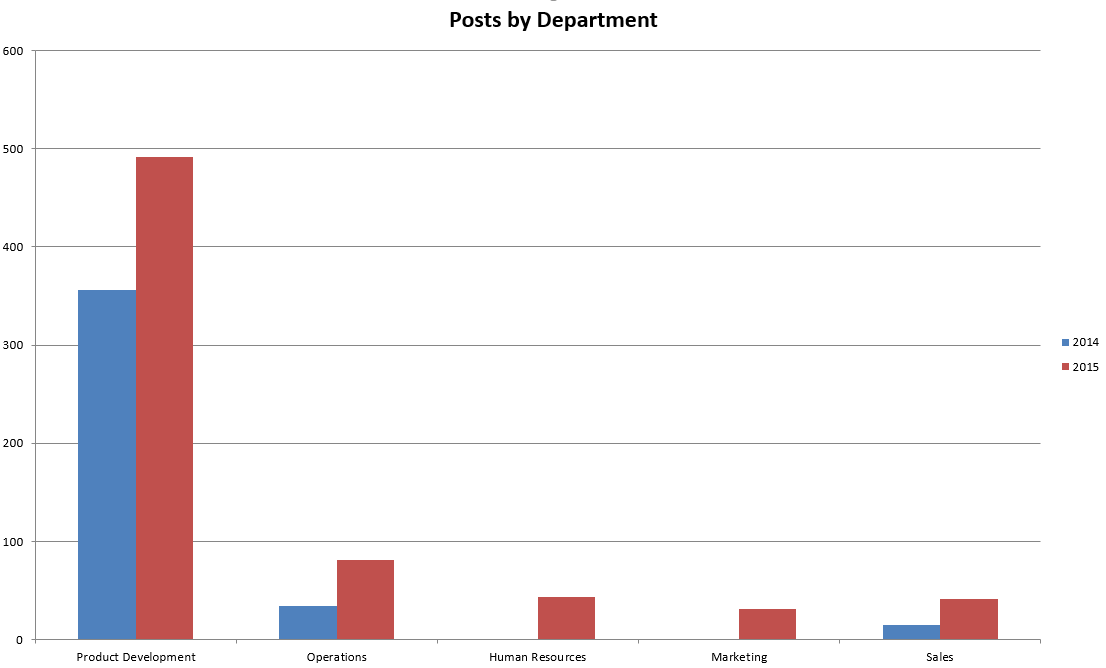How internal blogging with Confluence created a culture of knowledge sharing at APT
I wish I could say we started with grand plans to revolutionize our company culture, but in all honesty, we simply wanted to share funny stuff without sending an email blast. So, we tried creating a blog on Confluence. It didn’t happen overnight, but we learned a lot. Read on to hear our story, as well as my 7 tips to encourage a culture of internal blogging at your company.
This is a guest post by Dave Pacifico, Vice President of Engineering at Applied Predictive Technologies (APT) and longtime Confluence champion.
At Applied Predictive Technologies (APT) we blog on Confluence… a lot. But it hasn’t always been that way. It wasn’t as simple as sending out a staff-wide memorandum announcing all future communications would take place on internal blogs instead of email. It has been a long and winding road, but we’ve made huge strides in how we collaborate as a company and I hope we can help you do the same.

First, a little about us. APT is an enterprise software company based in Washington, D.C. We have roughly 350 employees across 8 offices around the world and a product development team of 90 people. We are growing fast. In the past year we’ve hired about 100 people. As we have grown, so have our communication and knowledge sharing practices, and blogging has played a key role in that. Today, we write an average of 75 blog posts per month across the company, and that number continues to grow.
Mapping out the problems to solve for
As we considered the switch from email communication to internal blog writing, we identified key problems we wanted to solve for. We were getting bigger and knowledge sharing was getting harder, specifically across our product development team. Here are some of the issues we found:
- People were reluctant to send emails to the whole team for small, but interesting topics.
- There was a desire to know more about what was going on across a growing number of development teams.
- We had a few huge meetings with the entire team that almost everyone hated.
- As teams grew, it was unclear who should be included in emails and key team members were often left out.
- We didn’t have a record of shared information and best practices for training our new hires.
Our first internal blog
I wish I could say we started with grand plans to revolutionize our company culture, but in all honesty, we simply wanted to share funny stuff without sending an email blast. So, we tried creating a blog on Confluence.
We simply wanted to share funny stuff without sending an email blast.
Our first blog was the “UX Fail” blog, which included cringe-worthy examples of bad UX that our team stumbled across on the web. The first post might be my favorite. Check out the dizzying array of options in this dialog box:
From 1 to 75 posts a month
Even with the excitement of this new blog, we didn’t jump straight from the UX Fail blog to writing 75 posts per month. Like most things, it was a gradual progression and an organic evolution rather than a top-down mandate. Our second blog had more substance. We were able to replace the increasingly unpopular team-wide meeting with a blog called “Share It”:
Share It is used to share anything and everything with the product development team. We post about team moves, major technology upgrades, team best practices, and even about our own blog statistics! The posts range from a few sentences to very long and detailed articles. This is still our most active blog today, accounting for 169 of our 786 posts (22%) in 2015. Most importantly, we use this blog to announce other new blogs so they can be discovered.
From Share It, we quickly split off other team-specific blogs for teams that had a lot to share. The architecture and DevOps teams were two of the first to have their own blogs, and soon enough nearly every development team had their own blog.
The watershed moment
2015 was a big year for us. We were acquired by MasterCard in May and that was a watershed moment in many ways. With such a big organizational change, there was a company-wide thirst for information and we realized email would not be enough. We set up a blog specifically for sharing information about the integration and for the first time, we had posts written by executives that were relevant to the entire company. This immediately increased awareness and blogging really caught fire from there, as you can see in the graph below.
From development to the rest of the company
Today, we have active blogs across nearly every functional area of APT. Product development still leads the way by a large margin, but there is great momentum. IT blogs about updates to internal software, useful troubleshooting, and how-tos. HR frequently posts about new hires and updates to benefit packages. Marketing shares APT news coverage and customer case studies, and Sales posts updates on big wins and new customer acquisitions we can all celebrate.
7 tips to get your company blogging on Confluence
Now that you’ve heard my story, here are some ideas to get your company started:
1. Identify early evangelists
Congratulations! If you are reading this post, you are most likely an early evangelist. Having one, or better yet, a few people championing the cause of team collaboration is one of the most important success factors. Listen for people talking about interesting things in the lunch room or hallways, and encourage them to blog about it. Contribute initial content to get it going. If posting slows down, write more.
2. Build writers up
Starting something new can be hard, so help people along the way. When you see a new post, give it some love. A simple “like” or enthusiastic comment can go a long way in encouraging people to continue writing. You can run a simple training session on how to blog or create a tutorial blog post. On Confluence you can watch each blog and encourage others to do the same. This will make sure you’re aware of progress and can continue your encouragement the moment a new blog pops up.
3. Don’t try to solve every problem at once
It’s okay to email out a link to a blog post for a while. Don’t force blogs to be the solution to everything right away and avoid imposing rules. A short, unstructured post with some interesting information is better than no post at all.
4. Start with a consistent, interesting blog that will keep momentum going
I can’t think of anything more generic than our Share It blog. We put anything and everything on there. Eventually it might get to be too much, but this approach is critical to keeping people thinking about blogging.
5. Break off content into separate, more specific blogs

For someone watching a blog, 70-80% of the content should be interesting to them or they’ll stop watching. Segment blogs into themes (technologies, individual teams, marketing, etc.). Don’t be afraid to create a new space just for a blog. Consider making a monthly post of “New blogs this month” or “Most popular posts this month” to help with discovery.
6. Add ways to know content is getting out there
We embed a view tracker on every blog post automatically. This helps, but it’s incomplete since most people just read the notification email without clicking in. For critical blogs like our MasterCard integration blog, we have auto-subscribed the whole company. We don’t do this often, but people are expected to read their email.
7. Get senior people involved
As I said earlier, it is amazing the impact a C-level executive can have when they make a post. Suddenly people really start to pay attention and they take blogging seriously as a way of sharing information. Getting these influencers on board will inspire others to join as well.
This is how blogging has worked for us at APT, but I’m sure it looks different at every company. Is it something your team does as well? I’d love to hear your experiences and advice in the comments below.
New to Confluence?
See how your team can replace team and company-wide emails with more effective knowledge sharing practices in Confluence today!




